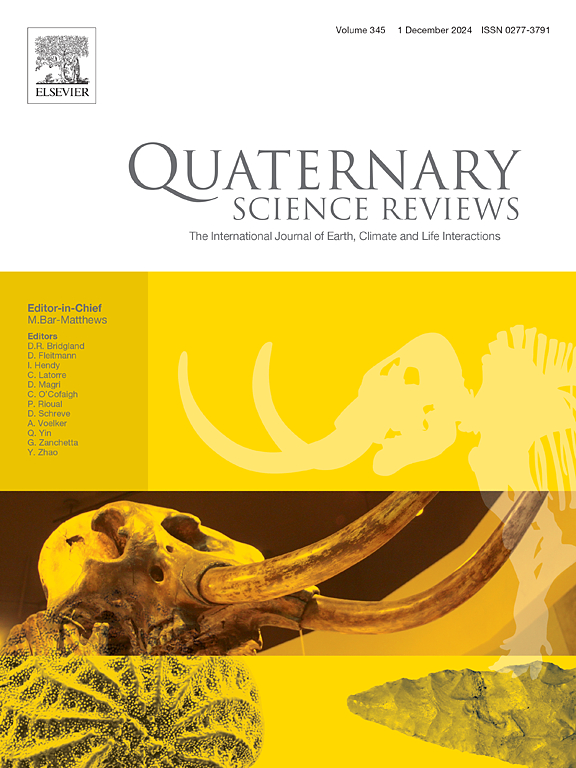Changes in the deep-water masses of the Eastern Mediterranean Sea during the last interglacial maximum - New constraints from neodymium isotopes in foraminifera
IF 3.3
1区 地球科学
Q1 GEOGRAPHY, PHYSICAL
引用次数: 0
Abstract
The thermohaline circulation of the Mediterranean Sea was a key factor in the development of sapropel layers in the Eastern Mediterranean Sea (EMS). Sapropel formation is linked to stagnant deep-water conditions and/or increased sea surface productivity during boreal summer insolation maximum. However, debates persist regarding the complex interplay between high and low latitude climatic processes, circulation dynamics, and sapropel formation. Analyses of major and trace elements by XRF, δ18O of planktonic foraminifera, and neodymium isotopes (εNd) of foraminifera have been carried out on two cores collected in the southeastern Aegean Sea of the EMS and in the Sardinia Channel of the Western Mediterranean Sea (WMS), in order to constrain deep-water mass circulation during the last glacial-interglacial cycle (i.e. the past ∼150 ka), focusing on the last interglacial maximum. When combined with previous εNd records from the EMS, we identified two regional patterns of the εNd variations during the sapropel S5 interval (∼128-120 ka), suggesting that the initial freshwater influx from North Africa led to marked water stratification, limited deep-water formation, and shifted foraminiferal εNd towards a local signature due to an extended period of Nd exchange between seawater and marginal sediments. Cores strongly influenced from the Nile River discharge display radiogenic εNd values (−3.7), whereas those from the northern EMS exhibit more unradiogenic εNd values (−5.1). As S5 progressed, εNd records of all cores from the Levantine basin indicate a slight mixing of deep-water masses accompanied by a decrease in the εNd gradient between the northern and southern EMS. This was associated with the global decrease in temperature and reduced Nile River water input, which supported a slight deep-water recirculation from the Aegean Sea. This active circulation conveyed radiogenic εNd from the southern EMS to the north and the Western Mediterranean Sea. Overall, our new results suggest that hydrological conditions in Mediterranean Sea fluctuated during the S5 deposition, with a slight recirculation of Aegean deep-water in a pre-stage before the complete recovery of circulation in the EMS at the end of the sapropel S5 deposition.
末次间冰期极大期东地中海深水团块的变化——有孔虫钕同位素的新限制
地中海热盐环流是东地中海(EMS)海水推进层形成的关键因素。在北方夏季日照最多的时候,沙推进体的形成与停滞的深水条件和/或海面生产力的增加有关。然而,关于高纬度和低纬度气候过程、环流动力学和砂冲力形成之间复杂的相互作用的争论仍然存在。本文对EMS爱琴海东南部和西地中海撒丁岛海峡(WMS)采集的两个岩心进行了主微量元素、浮游有孔虫δ18O和有孔虫钕同位素(εNd)的分析,以限定末次冰期-间冰期旋回(即过去~ 150ka)的深水团环流,重点研究末次间冰期极大期。结合前人在S5期(~ 128 ~ 120 ka)的εNd记录,我们发现了两种区域性的εNd变化模式,表明北非淡水的初始流入导致了明显的水体分层和有限的深水形成,并且由于海水与边缘沉积物之间的Nd交换延长了一段时间,有孔虫的εNd向局部特征转移。受尼罗河流量影响较大的岩心表现出放射性成因的εNd值(- 3.7),而来自北EMS的岩心表现出更多的非放射性成因的εNd值(- 5.1)。随着S5的推进,黎凡特盆地所有岩心的εNd记录均显示出深水块体的轻微混合,同时南北EMS之间的εNd梯度减小。这与全球气温下降和尼罗河水量减少有关,这支持了来自爱琴海的轻微深水再循环。这种活跃环流将辐射成因的εNd从南EMS输送到北地中海和西地中海。总的来说,我们的新结果表明,地中海的水文条件在S5沉积期间是波动的,在S5沉积结束时EMS循环完全恢复之前,爱琴海深水在前期有轻微的再循环。
本文章由计算机程序翻译,如有差异,请以英文原文为准。
求助全文
约1分钟内获得全文
求助全文
来源期刊

Quaternary Science Reviews
地学-地球科学综合
CiteScore
7.50
自引率
15.00%
发文量
388
审稿时长
3 months
期刊介绍:
Quaternary Science Reviews caters for all aspects of Quaternary science, and includes, for example, geology, geomorphology, geography, archaeology, soil science, palaeobotany, palaeontology, palaeoclimatology and the full range of applicable dating methods. The dividing line between what constitutes the review paper and one which contains new original data is not easy to establish, so QSR also publishes papers with new data especially if these perform a review function. All the Quaternary sciences are changing rapidly and subject to re-evaluation as the pace of discovery quickens; thus the diverse but comprehensive role of Quaternary Science Reviews keeps readers abreast of the wider issues relating to new developments in the field.
 求助内容:
求助内容: 应助结果提醒方式:
应助结果提醒方式:


